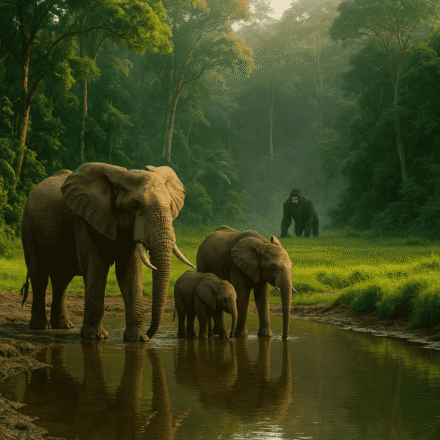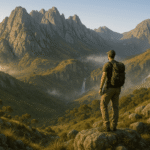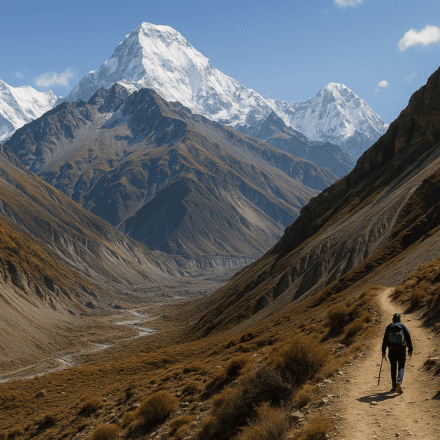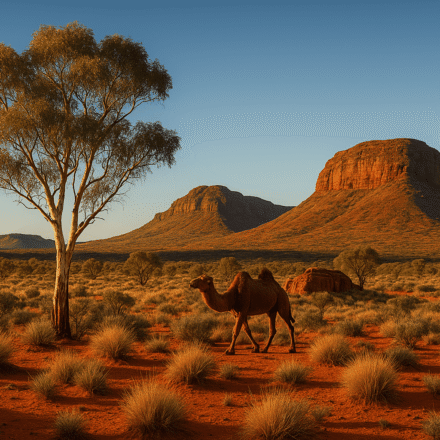Maya Nord: Wilderness Wonder of Odzala-Kokoua National Park in the Republic of Congo

The captivating Maya Nord, nestled within Odzala-Kokoua National Park in the Republic of Congo, stands as one of Africa’s most extraordinary wildlife havens. This natural forest clearing, known locally as a “bai,” draws adventurous travelers and passionate conservationists alike to witness its remarkable ecological spectacle. My first visit to Maya Nord left me speechless – watching dozens of forest elephants emerge from the dense jungle into this open clearing changed my understanding of wildlife completely.
Table Of Content
- The Magic of Maya Nord’s Forest Clearing
- Wildlife Spectacles at Maya Nord
- Biodiversity Beyond the Clearing
- The Ecological Significance of Maya Nord
- Research and Conservation Efforts
- Visiting Maya Nord: The Adventure of a Lifetime
- Frequently Asked Questions About Maya Nord
- Experience the Wonder of Maya Nord
The Magic of Maya Nord’s Forest Clearing
Maya Nord isn’t just any forest opening – it’s a lifeline for countless species in the dense Congo Basin rainforest. This special place creates a unique ecosystem where wildlife thrives in ways impossible elsewhere in the jungle.
What Exactly is a Bai?
A bai is a natural forest clearing created by specific geological conditions. At Maya Nord:
- The clearing formed through upwelling of mineral-rich water
- Geological formations date back approximately 10,000 years
- The mineral content in the soil attracts wildlife from miles around
- The open area spans approximately 0.18-0.23 km²
The Science Behind the Clearing
The true power of Maya Nord lies in its unique composition. The soil here contains minerals difficult or impossible to find elsewhere in the surrounding forest. These elements are essential for animal health, particularly for large mammals like elephants that require specific nutrients to maintain their massive bodies.
I spoke with a researcher who explained, “These clearings act as natural pharmacies for wildlife. The minerals here supplement their diets in ways the surrounding vegetation simply cannot.”
Wildlife Spectacles at Maya Nord
The biodiversity at Maya Nord is truly exceptional, with different species visiting throughout the day and night in carefully orchestrated patterns that minimize conflict.
Forest Elephants: The Stars of the Show
Forest elephants (Loxodonta africana cyclotis) are the most famous visitors to Maya Nord:
- Observed during 37% of daytime observations
- Average of nine individuals sharing the clearing at once
- Maximum recorded gathering exceeded 100 elephants
- Nighttime visits even more frequent (100+ individuals nightly)
These magnificent creatures differ from their savanna cousins with smaller, rounded ears and straighter tusks. Their behavior at Maya Nord has provided researchers with unprecedented insights into their social structures.
During my visit, I watched a family group led by an old matriarch teaching younger elephants which soil patches contained the best minerals. Their careful digging and selection showed remarkable intelligence and generational knowledge transfer.
A Gathering Place for Primates and Other Mammals
Beyond elephants, Maya Nord hosts:
- Western lowland gorillas (around 400 observed in the area)
- Forest buffalo in small herds
- Sitatungas (marsh antelopes) staying close to water edges
- Bush pigs and various duiker species
- The rare and elusive forest bongo antelope
- Shy forest mammals like pangolins and civets (primarily at night)
The interactions between species create fascinating dynamics. While elephants generally dominate the clearing, other animals carefully time their visits or stay at the periphery to avoid conflict.
Biodiversity Beyond the Clearing
Odzala-Kokoua National Park, Maya Nord’s home, ranks among Africa’s most biologically diverse protected areas with an astonishing array of species.
Winged Wonders
The area surrounding Maya Nord supports incredible avian diversity:
- Over 400 bird species documented in the national park
- More than 300 butterfly species fluttering around the clearing
- Numerous rare and endemic species found nowhere else
Birdwatchers visiting Maya Nord might spot rarities including the Congo serpent eagle, black-casqued hornbill, and African grey parrot. The morning chorus here creates one of the most complex natural symphonies on Earth.
Hidden Life Among the Leaves
The forest floor and understory around Maya Nord hide remarkable creatures:
- Scientists have identified 50+ species of amphibians and reptiles
- Many species remain unclassified or new to science
- The dense vegetation conceals countless insects and invertebrates
“The biodiversity here represents one of the most intact tropical forest ecosystems remaining on our planet,” noted one conservation biologist I met at the clearing. “Every visit reveals something new.”
The Ecological Significance of Maya Nord
Maya Nord functions as much more than a wildlife viewing spot – it serves as a critical ecological hub for the entire region.
Mineral Resources and Nutrition
The clearing provides essential nutrients otherwise unavailable:
- Elephants consume soil to obtain sodium, calcium and other minerals
- These nutrients support bone development and overall health
- Pregnant and nursing animals particularly depend on these resources
Water and Seasonal Importance
A stream running through Maya Nord provides reliable water access:
- Animals enter the clearing and head directly to the water source
- During dry seasons, this becomes even more critical
- The clearing’s importance shifts with seasonal changes
Research and Conservation Efforts
Maya Nord has become a significant site for scientific study, particularly regarding forest elephant behavior and ecology.
Groundbreaking Research
Scientists have conducted important studies at Maya Nord:
- Research on elephant “fission-fusion” social dynamics
- Documentation of group sizes and composition
- Population tracking of endangered species
- Identification of individual animals for long-term monitoring
Conservation Challenges
Despite its remoteness, Maya Nord faces threats:
- Potential ivory hunting (though currently controlled)
- Pressures from surrounding areas
- Need for expanded protection boundaries
- Historical impacts from Ebola on local gorilla populations
The ECOFAC project and other conservation initiatives work actively to protect this special place. Park managers recognize that clearings like Maya Nord represent both ecological treasures and potential economic resources through sustainable tourism.
Visiting Maya Nord: The Adventure of a Lifetime
For those brave enough to make the journey, Maya Nord offers wildlife encounters unlike anywhere else on Earth.
The Journey There
Reaching Maya Nord requires dedication:
- Up to 8 hours travel through dense rainforest
- Remote location far from conventional tourist routes
- Guided access essential for safety and conservation
When to Visit
Timing matters when planning your Maya Nord adventure:
- Dry season generally offers better viewing conditions
- Different species visit more frequently during certain months
- Early morning and late afternoon provide peak wildlife activity
Cultural Connections
The human element adds depth to any Maya Nord visit:
- The indigenous Mbeti people have inhabited surrounding forests for centuries
- Local knowledge enhances wildlife understanding
- Traditional ecological wisdom supports conservation efforts
I was fortunate to speak with a Mbeti guide who explained how his ancestors had visited Maya Nord for generations, observing subtle changes in wildlife patterns that helped them understand the forest’s health.
Frequently Asked Questions About Maya Nord
What makes Maya Nord different from other forest clearings in Central Africa?
Maya Nord stands out for its exceptional concentration of wildlife, particularly forest elephants. Research shows elephants visit during 37% of daylight hours, with nighttime visits even more frequent. The clearing’s specific mineral composition and reliable water source make it particularly attractive to diverse species.
When is the best time to visit Maya Nord?
The dry season (December-February and June-August) generally offers better access and visibility. However, wildlife visits the clearing year-round. Early morning (6-9am) and late afternoon (3-6pm) typically provide the best viewing opportunities when animals are most active.
How many elephants can I expect to see at Maya Nord?
While wildlife sightings can never be guaranteed, studies show an average of nine elephants share the clearing at once during daylight hours. At night, over 100 individuals may visit. During my visit, we observed 17 elephants in a single afternoon, including several family groups with young calves.
How do researchers identify individual animals at Maya Nord?
Scientists use various identification methods including:
- Unique ear notches and tusk shapes for elephants
- Distinctive “nose prints” for gorillas (similar to human fingerprints)
- Body size, scarring patterns, and other visual markers
- Modern techniques like DNA sampling from dung
What conservation challenges does Maya Nord face?
Despite its protected status, Maya Nord faces several threats:
- Potential ivory poaching (though currently well-controlled)
- Climate change impacts on water availability and plant life
- Surrounding forest pressure requiring expanded boundaries
- Need for sustainable funding for ongoing protection
Experience the Wonder of Maya Nord
Maya Nord represents one of Earth’s last truly wild places – a window into how forest ecosystems functioned for millennia before human interference. Its unique combination of geological features, mineral-rich soil, and strategic location within Odzala-Kokoua National Park creates an irreplaceable haven for Central African wildlife.
For those willing to make the challenging journey, Maya Nord offers wildlife encounters that seem transported from another time. Forest elephants quietly emerging from dense vegetation, sitatungas wading through shallow waters, butterflies erupting in colorful clouds – these moments connect visitors to the raw power of nature.
If you’re planning your next adventure, consider supporting conservation by visiting Maya Nord responsibly through authorized tour operators who prioritize sustainable practices and respect for this fragile ecosystem. Your visit not only creates unforgettable memories but helps ensure this remarkable place remains protected for generations to come.
Contact the African Parks Network, which helps manage Odzala-Kokoua National Park, to learn about responsible visitation options and how your tourism can support vital conservation efforts in the Republic of Congo.






